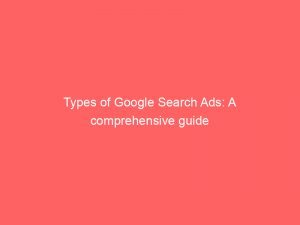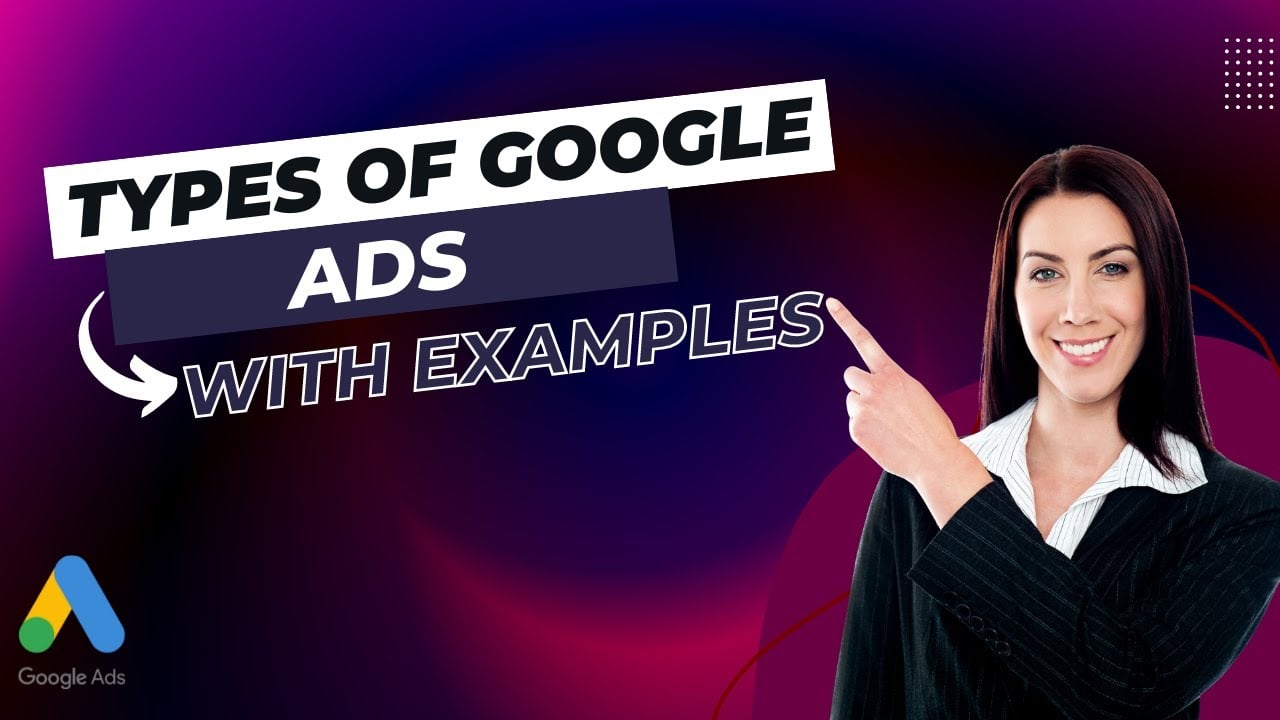With the ever-expanding digital landscape, Googlesearchads have become the go-to tool for businesses looking to boost their online presence. Picture the vast playground of Google’s search results, filled with 22 distinct types of ads, each with their own unique advantages.
From classic searchads that appear alongside search results to dynamic display ads that adapt to user behavior, the options seem endless. This article promises to unravel the secrets of these ad types, unveiling their pros, cons, and most effective applications.
Whether you’re a seasoned marketer or a curious entrepreneur, this guide will arm you with the tips and tricks needed to conquer Google’s advertising realm.
Table of Contents
- types of google search ads
- Introduction: 22 Types Of Google Search Ads
- Google Search Ads: Original And Effective
- Other Types Of Google Ads: Responsive, Call-Only, Dynamic Display, Single Image, Responsive Video
- Breakdown Of Each Type: Pros, Cons, And Suitability
- 1. Google Search Ads
- 2. Responsive Ads
- 3. Call-only Ads
- 4. Dynamic Display Ads
- 5. Single Image Ads
- 6. Responsive Video Ads
types of google search ads
There are several types of Google search ads that businesses can utilize to effectively reach their target audience. Some of the most common types of Google search ads include Search ads, Responsive ads, Call-only ads, Dynamic Display ads, Single image ads, and Responsive Video ads.
Each type of ad has its own advantages and disadvantages, and it is important for businesses to understand their unique features and benefits in order to choose the most suitable option. While Google Search ads are the original type of Google ad and attract high-intent traffic, they have limited branding and creativity opportunities.
On the other hand, Display ads can be cheaper and are effective for brand awareness but may have lower click-through rates. Video campaigns are great for visually showcasing products and driving brand awareness.
Shopping ads require a product feed and come in the form of Product Shopping ads and Local inventory ads. Smart campaigns are fully automated ads that cover various Google platforms, while Performance Max campaigns are goal-based ads that cover Google’s network.
Finally, Local Services Ads appear on Google Search and allow customers to directly contact businesses. Each type of Google search ad has its own unique advantages and limitations, and understanding these can help businesses achieve their advertising goals.
Key Points:
- Google search ads include various types such as:
- Search ads
- Responsive ads
- Call-only ads
- Dynamic Display ads
- Single image ads
- Responsive Video ads
- Each type of ad has its own advantages and disadvantages, and businesses need to understand their features and benefits to choose the most suitable option.
- Google Search ads attract high-intent traffic but have limited branding and creativity opportunities.
- Display ads are cheaper and effective for brand awareness but may have lower click-through rates.
- Video campaigns are great for visually showcasing products and driving brand awareness.
- Other types of Google search ads include:
- Shopping ads
- Smart campaigns
- Performance Max campaigns
- Local Services Ads
- Each serving specific purposes and platforms.
Sources
https://www.wordstream.com/blog/ws/2022/10/05/types-of-google-ads
https://sixads.net/blog/types-of-google-ads/
https://support.google.com/google-ads/answer/2567043?hl=en
https://support.google.com/google-ads/answer/1722124?hl=en
Check this out:
? Pro Tips:
1. Consider using Dynamic Display ads to attract customers who have previously visited your website but have not made a purchase. These ads can showcase personalized product recommendations based on their browsing history.
2. If you are looking to increase brand awareness, consider investing in Responsive Video ads. These ads can be displayed on YouTube and other partner sites, allowing you to reach a wider audience with engaging video content.
3. Don’t overlook the power of Shopping ads. By optimizing your product feed and targeting the right keywords, you can effectively promote your products and drive traffic to your online store.
4. Take advantage of Smart campaigns to save time and streamline your advertising efforts across multiple platforms. These fully automated ads can help you reach your target audience on Google Search, Maps, YouTube, and partner sites.
5. When setting up Local Services Ads, make sure to provide accurate and up-to-date information about your business. This will help potential customers make informed decisions and improve your chances of getting qualified leads.
Introduction: 22 Types Of Google Search Ads
Google offers a wide variety of advertising options to businesses looking to reach their target audience. Among the numerous types of Google ads available, there are 22 distinct varieties that cater to different advertising objectives and strategies.
From the original Search ads to the more visually engaging Responsive Video ads, each ad type comes with its own set of benefits and limitations. In this comprehensive guide, we will explore each type of Google search ad, providing insights into their pros and cons and discussing who they are best suited for.
Google Search Ads: Original And Effective
Google Search ads are the foundational type of ads where businesses bid on relevant keywords, and their ads are displayed at the top of search results. These ads have proven to be highly effective in capturing the attention of users who are actively searching for specific products or services.
One major advantage of Google Search ads is their ease of setup. With a few simple steps, businesses can have their ads up and running, targeting potential customers in no time.
However, while Google Search ads excel in attracting high-intent traffic, they do have their limitations. One drawback is the limited branding and creativity opportunities.
Since these ads appear as text-based listings, businesses may find it challenging to showcase their brand personality or use eye-catching visuals to capture users’ attention. Despite this limitation, the sheer effectiveness of Google Search ads makes them an essential component of any online advertising strategy.
Other Types Of Google Ads: Responsive, Call-Only, Dynamic Display, Single Image, Responsive Video
In addition to Google Search ads, there is a wide range of other ad types available on the platform. Let’s explore some of these options:
Responsive Ads: These ads automatically adjust their size, appearance, and format to fit any ad space available. Responsive ads are versatile and can be displayed on various devices, making them an excellent choice for businesses targeting mobile users.
Call-only Ads: Designed specifically for driving phone calls to businesses, call-only ads display a clickable phone number instead of a headline. This enables users to contact the business directly with a simple tap, streamlining the lead generation process.
Dynamic Display Ads: These ads leverage Google’s machine learning capabilities to tailor the content of the ad based on the user’s interests and behavior. Dynamic Display ads are highly customizable and can incorporate images, text, and even animation.
Single Image Ads: As the name suggests, these ads consist of a single static image. Single Image ads are a straightforward and cost-effective way to promote products or services visually.
They can be displayed across various websites within Google’s Display Network.
- Responsive Video Ads: A video-focused ad format, Responsive Video ads adapt to fit different video ad spaces across screens and devices. These ads allow businesses to create compelling video content that engages users and promotes brand awareness effectively.
Breakdown Of Each Type: Pros, Cons, And Suitability
1. Google Search Ads
Pros:
– Easy setup process. – Attracts high-intent traffic.
Effective for driving immediate conversions. – Cost-effective with pay-per-click bidding.
Offers precise targeting options.
Cons:
– Limited branding and creativity opportunities. – Relies on text-based listings instead of visuals.
- May face competition for popular keywords. – Requires ongoing optimization to maintain performance.
Suitability:
– Businesses looking to capture users actively searching for specific products or services. – Companies with limited advertising budgets seeking cost-effective options.
2. Responsive Ads
Pros:
– Versatile and adaptable to different ad spaces. – Automatically adjusts size, appearance, and format.
- Can display on various devices. – Dynamic and customizable.
Cons:
– Less control over the visual presentation. – Limited space to showcase detailed information.
- May require ongoing testing and optimization.
Suitability:
– Businesses targeting mobile users. – Companies with changing advertising needs and varying ad space availability.
3. Call-only Ads
Pros:
– Optimized for driving phone calls. – Simplifies the lead generation process.
- Direct and immediate contact with potential customers.
Cons:
– Limits interaction to phone calls only. – Requires a strong call handling system.
- May have lower conversion rates compared to form submissions.
Suitability:
– Businesses that prefer phone inquiries over other forms of engagement. – Companies with call center capabilities or dedicated phone sales teams.
4. Dynamic Display Ads
Pros:
– Personalized content based on user behavior. – Highly customizable with images, text, and animation.
- Effective for retargeting campaigns.
Cons:
– Complexity in setup and management. – Requires ongoing monitoring and optimization.
- Limited control over the specific appearance of the ad.
Suitability:
– Businesses with a diverse product lineup or broad target audience. – Companies looking to leverage machine learning to customize ad content.
5. Single Image Ads
Pros:
– Cost-effective visual advertising. – Simplicity in setup and management.
- Suitable for showcasing specific products or services.
Cons:
– Limited to a single static image. – Less engaging compared to videos or interactive ads.
- May require additional targeting to reach the desired audience.
Suitability:
– Small businesses with a limited budget for advertising content creation. – Companies seeking a straightforward and visually appealing ad format.
6. Responsive Video Ads
Pros:
– Effective for visual storytelling and brand awareness. – Automatically adapts to different video ad spaces.
- Engaging way to showcase products or services.
Cons:
– Requires video content creation. – May require additional optimization to ensure compatibility across devices.
- Limited space for detailed information.
Suitability:
– Businesses with compelling video content. – Companies aiming to boost brand awareness through engaging video ads.
(Continued in next message)












